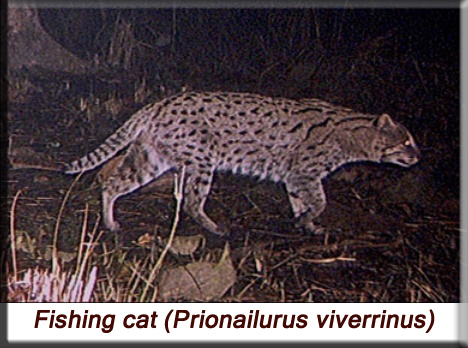Rehabilitation of hand-raised felids - small cats
Devna Arora
For the care of orphaned kittens, please have a look at our
hand-rearing protocol
Felids
The family Felidae comprises of cats and includes both large and small cats. Although similar in feeding behaviour, there are marked differences between most species – size being a crucial differentiating factor. While smaller cats can survive on rodents and other smaller prey, large animals like lions and tigers need to hunt large prey to meet their energy requirements. Although they are equally adept on land, species like the Fishing cat even specialize in an exclusive niche – aquatic prey.
Cats are born hunters. Their entire body – the eyes, the ears, the tail and their gait is specifically designed to hunt. Being extremely light-footed, their hunting strategy involves creeping up on prey and pouncing at close distances. Even their colours help them blend in with their surroundings making them virtually invisible until the final pounce.
Take the house cat for example – it has accompanied man everywhere simply because of its ability to keep rodents in control. Domestic cats are such able hunters that they kill billions of smaller wildlife each year. They are also known to become feral with ease. In the year 2003, 9 million pet cats were estimated to have killed at least 220 million animals (small mammals, birds and reptiles) in an island as small as Great Britain alone. This figure does not include predation by the additional 0.8 million feral and semi-wild cats in Great Britain that would have relied almost exclusively on wild animals. This shows you the hunting ability of a cat.
Hunting: Instinctive vs. Learned behaviour
Hunting behaviour or rather, the tendency to stalk and pounce is instinctive in cats. Even domestic cat kittens start stalking and pouncing on moving objects when they are little as a month old. It however takes tremendous amounts of energy, skill, focus, experience and strategizing to become a successful hunter and accomplish the task consistently. Although any cat can kill an animal occasionally, a wild cat must be able to hunt frequently and successfully enough to meet all of its energetic demands. It is only with time and experience that they learn to do so.
Just as predators are designed to hunt, prey animals are designed to flee. Their fleeing mechanisms are so strong that the best of hunters are often only successful one in 5-6 times. With age, time and experience, they learn to strategize and plan their moves to maximize their chances of a successful hunt. In the wild, the kittens learn to hunt with their mothers and are fed by the mothers (and other family members in case of lions) until they become able hunters. This ensures adequate time to experiment, play and develop their hunting skills.
Rehabilitating wild felids (small cats)
Small cats are classified as the smaller of the felids that typically weigh less than 20 kilos. They are all nocturnal in behaviour, primarily inhabiting forests but readily move through rural and suburban areas and live on small mammals, reptiles, amphibians and birds.
N.B. This document has been made keeping in the mind the requirements and rehabilitation guidelines for small cats in the Indian sub-continent.
The key to success when rehabilitating predators is hunting practice. The more opportunities they are given, the more they will learn and the better they will become. Each young cat must go through at least 3-4 months of hunting practice before being released.
The cats must also be shifted to larger enclosures [minimum 15x25 feet] in the last stage of rehabilitation before release. The enclosure must have appropriate dens and nest boxes and plenty of habitat enrichment in the form of trees, perches and ground litter. Catching prey in an enclosed space is very easy but an unlikely scenario in the wild. Hunting ability must be judged in a larger space before releasing the young cats. Additional hunting practice must be given to cats that do not appear to be ready and release must only be done at a stage where survival is likely.
Fishing cats (Prionailurus viverrinus)

Fishing cats consume both terrestrial and aquatic prey. In addition to the normal prey items given to the other cats, they must be given additional practice with aquatic prey. Their enclosures must have small water ponds with live fish, crustaceans or amphibians introduced at least twice a week.
Do’s & Don’ts for hunting practice
White mice are inadequate
White mice have almost no reflexes or speed. They usually show no recognition or fear and seldom react to predators. While they are ideal to begin hunting practice, a cat’s hunting ability must never be judged by its ability to successfully catch white mice.
Introducing white rats
Contrary to white mice, rats are capable of delivering nasty bites and it is preferable to avoid using them in the first stage of hunting practice.
Mice caught from human-inhabited areas
Refrain from catching mice in human inhabited areas as there are high chances of baiting poisoned mice but if doing so, hold on to them for a day or two and ensure the lack of ingested poisons before offering them as prey.
Using wild mice
Ensure you don’t disturb the balance of native fauna or end up catching another endangered species. Please be in touch with your local conservation and management authorities and ensure to seek adequate permissions before attempting to catch wild mice.
Legalities – live prey may be illegal
Please ensure you are not in violation of any legality by offering live prey for hunting practice. If the practice has been banned in your state or country, other means such as the use of toys must be explored.
Use of toys for hunting practice
The primary objective of hunting practice is to build speed, focus, and agility thereby maximizing chances of successful hunting. These can also effectively be achieved through toys and other moving objects. Caution must be taken to ensure no part of any broken toys can be ingested.
Timeline of Rehabilitation and Release
Weaning and introduction of meats
Small cat kittens are weaned at an average age of 7-8 weeks. Meats are introduced to their diets by the time they are 3-4 weeks old and they are completely reliant on animal-based foods once weaned. This is a good time to introduce whole pieces of meat that the kittens can learn to tear into and also begin hunting practice. Once weaned, the kittens must follow nocturnal feeding routines where food is provided at least 2-3 times a day – dusk, night and just before dawn. The necessary vaccinations must also begin at this age.
2-4 months – introducing easy prey
Kittens may be offered easy prey like white mice and small chicks (poultry) to begin hunting practice. They may initially only pounce on the prey without actually killing it or knowing what to do next. Once they are able to successfully kill and consume smaller prey, white rats and older chicks may be introduced. The kittens may be housed in smaller enclosures (10 x 10 ft.) at this age. All gaps preventing the escape of live prey must be covered before hunting practice begins. Human contact must be minimal at this stage.
4-6 months – hunting for survival
Feeding at this age may be reduced to 1-2 feeds a day – once at dusk and once either at midnight or just before dawn. Feed may be dropped to once a day when providing larger prey.
The kittens must be shifted to larger rehabilitation enclosures and difficult prey, requiring absolute skill and agility, must be introduced. For example, if using chickens for practice, refrain from using broiler chickens (white coloured) at this stage. Instead, use desi chickens – the multi-coloured ones that are bred locally. At least 50% of their food must be provisioned through self-caught prey.
Hunting practice must be done with a variety of animals to prevent reliance on any one animal, esp. animals like poultry. This would prevent the cats from specifically seeking out farmed foods and preventing them from becoming a nuisance; thus increasing their chances of survival after release.
5-6 months onwards – release
The soft release process may begin by the time the kittens are 5 months old, while kittens undergoing a hard release must be at least 6 months old.
Considerations for release
Release must be considered in any appropriate location with an existent natural distribution of the population. Fishing cats would additionally require riverine and mangrove habitats. The release site should preferably be devoid of any direct threats and must allow release in safe manner. Being nocturnal in nature, the cats must be released at dusk.
If opting for a soft release, the kittens must be shifted to an appropriately sized in-situ rehab enclosure by the time they are 3-4 months of age and soft release procedure may begin by the time they are 5 months old. Supplemental feeding at or near the enclosure must be continued at least for a few weeks until the kittens are 7 months old and fairly independent. Do keep in mind that hand-reared animals take longer to become self-sufficient than parent-reared wild animals.
All kittens must undergo a satisfactory health check and they must all be dewormed and vaccinated prior to release.
Acknowledgements
I’d like extend my heartfelt thanks to Rupa Gandhi Chaudhury for permitting me to use these beautiful photographs of Jungle cat kittens. Thanks so much, Rupa!
References
Arora, D. (2013) Neonate care: Hand-rearing new-born kittens, Rehabber’s Den [Online]. Available from:
http://www.rehabbersden.org/Neonate%20care%20-%20Hand-rearing%20new-born%20kittens.pdf [Accessed: 20/02/2013]
IUCN Red List (undated) Prionailurus viverrinus (Fishing cat) [Online]. Available from: http://www.iucnredlist.org/details/18150/0 [Accessed: 09/07/2013]
Mellen, J. D. (undated) Zoo standards for keeping small felids in captivity [Online]. Available from:
http://www.nagonline.net/HUSBANDRY/Diets%20pdf/Zoo%20Standards
%20for%20Keeping%20Small%20Felids%20in%20
Captivity.pdf [Accessed: 11/09/2012]
RSPB (2013) Are cats causing bird declines? [Online] Available from: http://www.rspb.org.uk/advice/gardening/unwantedvisitors/cats/bird
declines.aspx [Accessed: 06/07/2013]
Woods et al. (2003) Predation of wildlife by domestics cats Felis catus in Great Britain [Online]. Available from:
http://homepages.abdn.ac.uk/nhi775/cat_predation.htm [Accessed: 06/07/2013]





